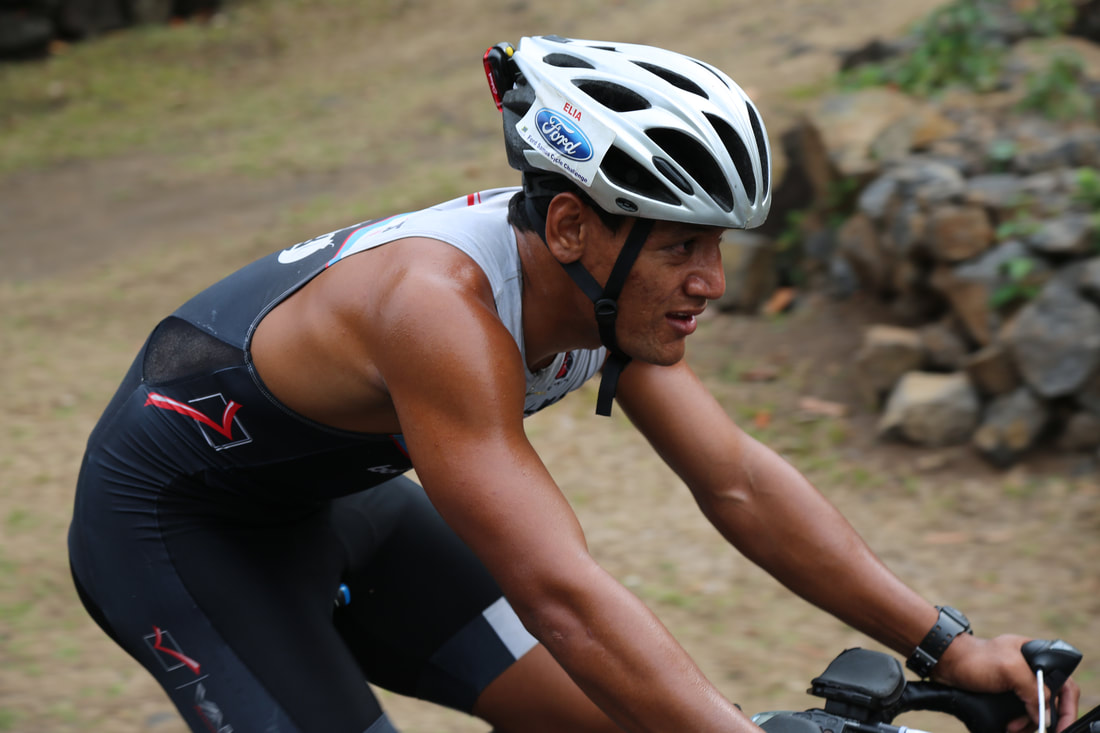|
Looking back to 2014 Elia Lasa has achieved what no one else in Sāmoa has done before. On Tuesday at 7:30 pm, the rider from Falefā village in Anoama’a East completed a cycle ride around Upolu and Savai’i in less than 24 hours. He can now rightfully claim the title of Sāmoa’s Supreme Cyclist of the Year award, and no one will dispute it. He is the Lance Armstrong of Sāmoa Cycling, but without the use of drugs.
The gruelling challenge involved covering 370 km of tough riding on two islands, navigating rough surfaces, facing numerous dog chases through the night, taking two ferry rides, enduring extreme heat, conquering steep hill climbs, all with hardly any sleep. This achievement comes just over two weeks after completing the Ford Samoa 3-Day Cycle Challenge (later to become the Tour of Sāmoa). During that event, Elia was one of three riders to complete the 3-Day event, covering a shorter course of 356 km and finishing in third place. However, the difference this time was that Elia rode non-stop over a longer distance, all within a single day. He was the sole survivor until the end. The 24-Hour Challenge commenced on Monday night at 8:30 pm at the Apia Town Clock. Twenty-three hours later, at 7:30 pm on Tuesday night, Elia returned to the same spot after circumnavigating Upolu and Savai’i. On Monday night, three riders - Li'ali'aalefao Daniel Afoa, Dave Leng, and Elia Lasa - set off from the Town Clock and rode clockwise around Upolu. As people retired for the night, the riders quietly pedalled through darkened villages, displaying remarkable determination. I followed them in the support vehicle on high beam to illuminate their way. At 11 pm, we reached the summit of Le Mafa Pass. At 1 am, we took our first break at Lalomanu outside Aga Resort. It was a chance for the riders to refuel, eat, check their bikes, replenish fluids, and then continue the journey. We rode non-stop from there to Mulifanua wharf via Faleālili and Lefaga, arriving at 3:15 am. It was a remarkably fast pace. We lost a rider there (Leng), but two continued on to Savai'i for the arduous task ahead. We made further preparations at Mulifanua, including a cold wash, changing clothes, consuming food and fluids, and then some sleep before the 6 am ferry. The crossing on the slow ferry allowed more shut-eye for the riders. It was surprisingly faster than usual, which worked in our favour. Once on Savai’i, Daniel and Elia, both from Falefā, got back on their saddles and rode clockwise around the big island. The key to completing the challenge was reaching Sālelologa by 4 pm to catch the ferry back to Mulifanua. The plan was to reach Āsau by 11:30 am, Sāleaula by 2 pm, and Tuasivi by 3:20 pm, ensuring they made it to the ferry before 4 pm. We reached Āsau right on time at 11:30 am, after covering 95 km of continuous riding without a break. The decision to take the clockwise route was made carefully by Daniel, simply to avoid a long ride into the headwind late in the day if they had gone the opposite way. Although there was still some headwind on the Itū o Tane side, it offered more natural buffering from the wind. The ride to Āsau via Gataivai and Itū Sālega presented its own challenges. The first 20 km were very rough for the bikes, as the road seal disappeared. Then came the climbs at Sālega and Falelima. However, these challenges were offset by the long descent down the hill at Papa Sātaua. This descent was another reason for choosing this route, as it avoided the long climb from Papa to Faleālupo going the other way. Upon reaching Āsau, we rested by the village pool. Daniel and Elia immersed themselves in the cool village pool of natural spring water; refilled their water bottles, ate more food, donned new riding gear for the next leg, and restocked on gels and salts for the upcoming hills. The equation now was to cover 85 km in 3.5 hours, which was doable under normal circumstances. However, it was exceptionally hot, and the rising hills between Asau and Aopo posed a significant challenge. Despite the gains made by reaching Āsau on time, these were quickly lost on this leg. Daniel and Elia were beginning to feel the strain, much like poorly maintained machines. They had to take regular unscheduled breaks, consuming ice and gels in large quantities. However, these were only temporary solutions, as their bodies protested against the abuse inflicted on already aching limbs. Time was now of the essence, and it was slipping away rapidly. It was agonising to follow the riders in the support vehicle, especially during the steep and slow climb from Āsau. We limped tenderly to Āopo, and even the downhill ride from there was slow, as their sore bodies could not fully take advantage of the descent to Sāsina. Elia was in physical pain from tight leg muscles, so much so that I offered him a ride on the back of the support vehicle for the rest of the journey through Savaii. He looked at me with a pained expression and shook his head. He was determined to continue. We had 70 km to go and only 2.5 hours to reach our destination. Daniel still believed that they could make it to the ferry by 4 pm. However, we needed to pass Tanu Beach by 1:45 pm and be at the 35-km mark with 90 minutes to spare. Elia and Daniel were on pure survival mode, and it was remarkable that they reached the designated waypoints in those timeframes. At the three corners at Sāmalaeulu, with 35 km to go and 90 minutes left before the ferry, Daniel was confident they could make it. On all accounts, Elia was lagging behind Daniel by up to 2 km at times. Nonetheless, he continued to pedal on as though his life depended on it. Then, we needed to reach Puapua in 30 minutes and have an hour left to cover the last 20 kilometers. It was a challenging task, but Daniel was surging ahead while the support vehicle stayed with Elia. The focus was on getting Daniel to the ferry, with the plan to pick up Elia if he got too close to 4 pm. Then, the unthinkable happened at Puapua - Daniel, the leader, was physically incapacitated by his own cramps and could not continue, no matter how hard he tried. His ride was over. Elia, riding like a robot, continued to ignore the pain. With Daniel out of the ride, our focus shifted to getting Elia across the finish line. He rode past Lano and then Faga. With twelve km to go and forty minutes remaining, we left him with a pep talk and a cold can of Coke for a sugar rush. "You can do it! Only 12 km to go, which is the distance from Solosolo to Falefā, and you have to do it in under 40 minutes." With those instructions, we took off to secure our vehicle's berth on the ferry, placing all our faith in Elia to reach the ferry before it sailed at 4 o'clock. The support vehicle was on the ferry, and all we wanted was for Elia to arrive quickly. Ten minutes before departure, there was no sign of him. We explained the situation to the ferry personnel, but they insisted the ferry would sail at 4 pm. Still no sign of Elia with 7 minutes to departure. Then, we spotted him, riding like a robot but with speed toward the wharf. He had done it. He made it with six minutes to spare. Once he was on the boat, the bridge was drawn, and the ferry set off before 4 pm. The ninety-minute ferry ride to Mulifanua provided Elia with much-needed rest. He still had 35 km to ride once we landed on Upolu, with the finish line at the Apia Town Clock. Daniel was exhausted, and with his ride ended, the new plan was for him to join Elia closer to town for the final ride to the Town Clock. Upon landing, both Daniel and Elia suited up and rode at a slow pace for the last 35 km. They rode like novice riders, battling fatigue, tiredness, and a stiff headwind. Despite the challenges, they inched closer to their goal. Finally, we reached Apia, and the sight of the Town Clock from Taufusi brought welcome relief. We were home. The time was 7:30 pm. Elia completed the challenge in 23 hours, achieving the seemingly impossible. Throughout the journey, there were numerous other challenges and obstacles. During the night on Upolu, packs of dogs in almost every village gave chase. Potholes filled the roads in many places, making the riding conditions exceptionally tough. However, the biggest challenge lay ahead on Savai’i. The long, steep hills of Sālega, Falelima, Āsau to Āopo, and the stretch between Sāmalaeulu and Puapua began to take their toll on the riders. Add the intense heat to the already challenging equation, and it made for incredibly tough riding conditions. Elia overcame all these obstacles, and his supreme achievement rightfully earns him the title of the undisputed long-distance cyclist in Sāmoa for 2014. He deserves recognition and reward for his courageous and fearless mindset. Elia faced physical troubles with back pain throughout the ride, yet he refused to give up. After the ride, he said, "My back was very sore and it was hurting me badly, but I did not want to give up. I wanted to complete the challenge." "Once Daniel was out, I wanted to make sure I continued, otherwise the whole exercise would have been in vain with no one finishing the challenge." We were fortunate not to encounter any punctures or mechanicals on the entire ride. This humble village kid has accomplished what no one else has done before, and it will be a long time before anyone else can complete this challenge, let alone attempt it. The recognition as the Supreme Cyclist, if not in all of local sports, is undoubtedly his for this year. All Hail Elia Lasa! Elia would complete this challenge for a second time in 2015 with Daniel and Darren Young as new finishers of the 24-Hour Cycle Challenge. The ride has not been attempted since. Subscribe Here
0 Comments
Leave a Reply. |
Archives
May 2024
Samoa Swims & Events news
Categories |

